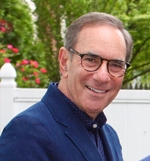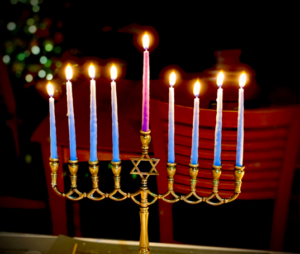By Michael R. Mantell, Ph.D.

SAN DIEGO — This week’s parasha, Miketz, comes on Chanukah and on Rosh Chodesh Tevet. Yet, Chanukah isn’t mentioned even once in all of our Torah. Recall that in last week’s parasha, Vayeishev, Joseph was thrown into a pit. Joseph prayed and Hashem answered his prayers. This week, we read how his life changed, how Hashem saved his family and by extension, our lives as Jews as well, and Joseph now prayed prayers of thanksgiving…as do we, for Hashem delivering us miraculously as he did Joseph. Our endurance has little to do with military capacity or political perceptiveness, both clearly important, but rather from our own inner determination that is launched in our faith. This is the link between Miketz and Chanukah.
We learn that Chanukah commemorates two events, the military victory of the Maccabees in 165 b.c.e, and the miracle of the small cruse of oil, which burned in the Temple for eight days. The miracle of the oil was emphasized by the early Rabbis over the military victory, which they did not regard as miraculous. The miracle of the oil is, as we know, a foundation for why candle lighting, an act of “pirsuma d’nisa” (publicizing the miracle), is one of the two major commandments of Chanukah, with reciting Hallel as the other.
Through lighting candles, we are able to display our hope in Hashem, His role in our lives, and our faith in His gifts. Like Jacob who also engages in “pirsuma d’nisa” by continually giving recognition that his powers, his gifts, are from Hashem, we do so each of the eight nights of Chanukah. For example, Joseph tells Pharaoh that the plan to save Egypt from impending famine is a “matter that has been determined by Hashem and that Hashem will carry it out” (Genesis 41:32).

Lighting candles is so important to us that Rambam z”l writes, “Even if one has no food, he must borrow money or sell his shirt to buy oil for Chanukah lights.” And R’ Vidal di Tolosa z”l (Spain; 14th century; the “Maggid Mishneh”) explains, “Since halachah requires a person to borrow money or sell his shirt to buy four cups of wine for Pesach, certainly he must borrow money or sell his shirt to buy oil for Chanukah, since Chanukah candles involve pirsuma d’nisa.”
But sometimes it is difficult to celebrate with light, given the seemingly dark times that surround each of us. From hate, violence, rising antisemitism, and bigotry, to declining faith and religious observance among Millennials in particular, “pirsuma d’nisa” may be a particular challenge. But perhaps that’s what the real miracle is in our lives…to understand and see what Hashem means by “va y’hi ohr,” “let there be light.” That even when it’s the worst, it’s the best. We can see during the darkness and fulfill our duty to bring light.
Rabbi Isaiah ben Avraham Ha-Levi Horowitz (1568-1630), known as the Shlah after the title of one of his major works Shnei Luchos Ha-Bris, was a renowned halachist, kabbalist and communal leader. He teaches us that the 36 candles we use for our “pirsuma d’nisra” during the eight nights of Chanukah, correspond to the 36 hours that we communed with Hashem in the Garden of Eden. When we light the Chanukah lights, reserved for a holy purpose and no other, we have the opportunity to connect with creation, with all who came before us.
Joseph continued to publicize the role of Hashem regardless of what he faced. Where and how will you bring His light into the darkness of our world? Parasha Miketz, indeed Chanukah, comes to assure us that we are made in Hashem’s image, and that means we have the ability, the strength, the obligation, to bring light into this world. When we place our menorahs in our windows, we say to the world that we will not remain hidden but will publicly show that the light we were given, always will be there for us to help us continue to overcome our adversaries and our adversities.
Just as the oral law is required to illuminate and elucidate our written law, the menorah, placed as it was in the Holy Ark, illuminated the area of the Holy of Holies, which contained the tablets and the written law. It can be said that the menorah represents the oral law in that like the menorah, the oral law is synonymous with mesiras hanefesh, self-sacrifice, needed to understand and live by the written law. The self-sacrifice of the Chashmanoyim who fought to live as Jews, was a key reason for the victory over the Greeks. Hashem brought us the menorah as the way to show us the miracle of Chanukah, not through any other way.
We need to do our best as “candle lighters” and to remember the lessons underlying the reasons that we do light candles. Chanukah is an opportunity to rekindle our inner tainted Ner Tamid. The rituals of Chanukah bring us the opportunity to “practice the pause” and multiply our efforts to rekindle and refresh our inner menorah. Even the dreidel can teach us a bit of self-improvement linked with our faith in Hashem. All it takes is one “turn” of events from Hashem, one spin of His, and our seeming adversity turns into something for our good. In the middle of darkness, we spin a dreidel and turn on the light for the world. We place our menorah near the doorway of our homes, toward the outside, to remind us not to focus only on ourselves and our own good, but to think about others and how we can bring goodness to the world. How we see ourselves, as able to bring the message of Hashem, of being a light unto the nations, of placing Him before ourselves, are important ways for us to do so.
Reb Nachman, the Hasidic master, (b. 1772) suffered with what we know as depression. He demonstrated his skill as a master teacher in that he taught is that despair is a sin, since despairing means the complete absence of emunah and bitachon. This means giving up on all that is around and within us, our own strength, and on Hashem.
It’s been shown that the word דאגה which means “worry,” is made up of consecutive letters of the alphabet, excluding the letter “ב” hinting to the fact that who worries or mistrusts too much is missing this letter, as in “בתהין” meaning trusting in Hashem.
And if we truly give up, lack trust, and erroneously believe that we can no long bear pain, we will not work to repair what’s broken. Yet, isn’t that what we are as Jews, people who bring tikkun olam, repair to our broken world?
Like Joseph, do we carry our personal relationship with Hashem with us daily, up front in our minds, no matter what else is going on in our lives? It’s easy in our secular world to put our relationship with Him in a “tab” for us to open when we need Him. It’s not just a Friday night, Shabbat morning, or Rosh Chodesh relationship that we have. That’s not what the light of Chanukah, a wonderful occasion for reflection and inspiration, teaches. Torah and spirituality win out in the story of Chanukah, not materialism and daily business matters. What do we let stand out and publish in our lives? When we light our candles, let’s be reminded that Hashem is not an app that we sometimes open, and instead let’s bring spirituality into our vision continuously, being the light in an otherwise dark time. Torah, mitzvot, personal behavioral and mindset change, can all help us be a continual flame.
Rabbi Nechemia Schusterman, of the Chabad of Peabody Jewish Center, brings an interesting observation, “Remember the old JFK line: “Ask not what your country can do for you, but what you can do for your country.”
I propose that a deeper message of Chanukah is: “Ask not what your lights will do for you, but what your lights will do for others.”
Finally, there is a story of Rabbi Chanina Ben Dosa in the Talmud (Taanis), of his daughter who was sad because somehow the oil on erev Shabbat was substituted for vinegar and would not light. Her father said that Hashem would intervene and make the vinegar burn, which He did, and it burned through Havdalah. We learn from mussar that oil is a symbol of the Maccabees, more Torah-observant Jews, while vinegar is symbolic of more assimilated Jews. This parable teaches us that all Jews can and will one day come together, united ever closer in Judaism, and remain so to Havdalah.
We are always being asked to defend our faith and our homeland, in our lifetime, perhaps more now than ever. We have many role models who’ve stood up to antisemitism and overwhelming odds. Each time, there has been a mighty reward awaiting those guardians of our faith. Following the Maccabees victory, they discovered the oil in the Temple vanished and it seemed there was only enough for one night. With faith, they lit it anyway and, well, you know the story. It’s a story of resilience and hope (“having only positive expectations”).
As we light our candles this year, be sure to take a moment, practice the pause, and reflect on how you are fostering your own resilience, equanimity, and strength following in the footsteps of the Maccabees. The world is watching to see how our generation responds.
*
Michael R. Mantell, Ph.D., prepares a weekly D’var Torah for Young Israel of San Diego, where he and his family are members. They are also active members of Congregation Adat Yeshurun. He may be contacted via michael.mantell@sdjewishworld.com